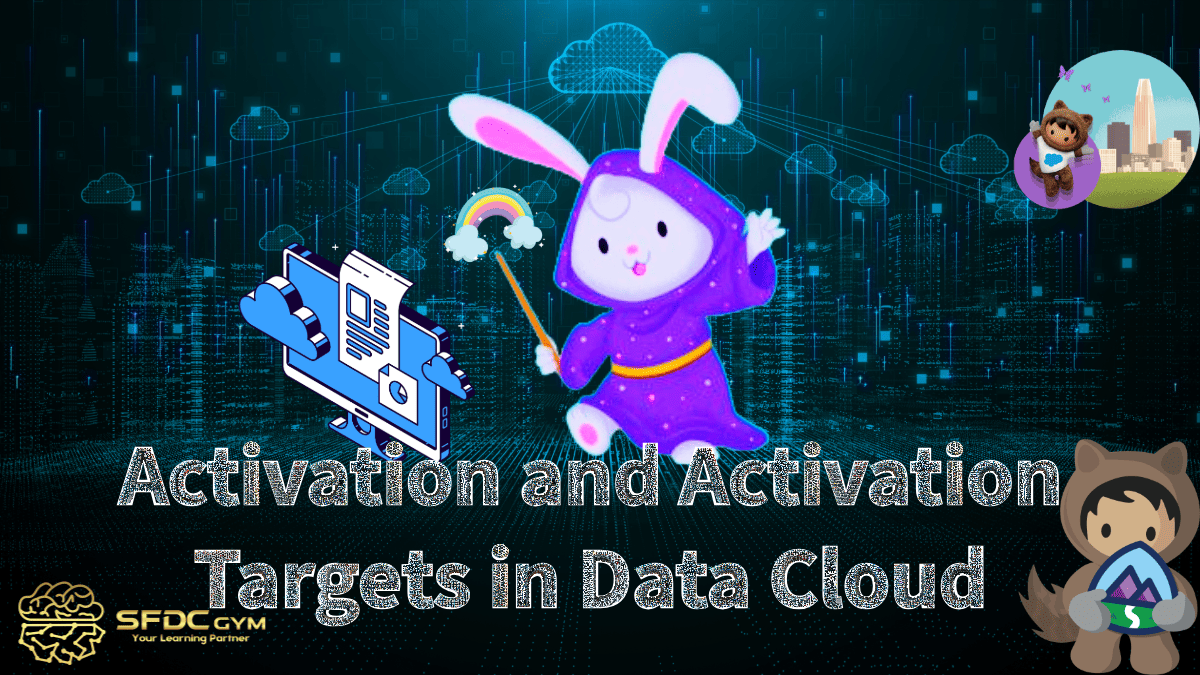Activation and Activation Targets in Data Cloud



Activation and Activation Targets in Data Cloud
Activation is the next logical step in leveraging customer data for exceptional results. Once you’ve segmented your audience, what comes next? This blog explores Activation and Activation Targets within Salesforce Data Cloud and shows how businesses can put their curated segments into action to create meaningful customer experiences.
Whether you’re a Data Cloud Architect or an Engineer, this guide will equip you with a deep understanding of how Activation works alongside practical examples to get you started.

What is Activation in Data Cloud?
Activation in Data Cloud refers to the process of utilizing customer segments for specific actions across various platforms. These actions might include personalized advertising, email marketing, or tailored content delivery based on the unique attributes of different audience groups.
Essentially, activation takes your segmentation insights and makes them actionable, ensuring that your campaigns are targeted, effective, and relevant. Activation bridges the gap between insights derived from data and real-world engagement, bringing tremendous value to marketing, sales, and service efforts.
For instance, imagine you’ve created a segment of urban-dwelling Android users who have shown interest in your mobile app. Activation would involve delivering a specific promotion for an Android app tailored to their needs across relevant channels such as Google Ads or email campaigns.
What Are Activation Targets?
An Activation Target is the destination where segments are used, whether within a Salesforce platform or an external advertising or marketing system. These settings need to be configured to allow segments to communicate with these destinations efficiently.
Once configured, Activation Targets distribute segmented data to these locations, enabling targeted outreach and relevant engagement. Different Activation Targets have specific requirements; for example, some require authentication details, while others come with pre-configured connectors.
Examples of Activation Targets include:
Salesforce Platforms like Marketing Cloud.
External Platforms such as Google Ads, Meta Ads, and Amazon S3.
Businesses can tailor Activation Targets to align with their goals and workflows, ensuring seamless integration and data usage.
Key Considerations for Activation Targets
Authentication and Permissions
Activation Targets require user authentication and platform permissions to function. For example:
Amazon S3 setups involve configuring specific credentials.
Marketing Cloud Activation needs permissions for shared data extensions.
Privacy & Compliance
When working with Activation Targets, privacy compliance is crucial. Salesforce ensures that activation respects privacy regulations, including California Privacy Rights Act (CPRA) compliance. Regardless of the target, businesses should configure privacy settings appropriately for global regulations like GDPR and CCPA.
Pre-configured vs. Manual Activation
Some targets like the B2C Commerce Connector come pre-configured and auto-created for seamless integration. Others require manual setup, making it necessary to input credentials and customize the configuration in the Data Cloud interface.
How to Set Up Activation in Data Cloud
Now that you understand Activation and its Targets, the next step is enabling and using activation effectively. Here’s a simple guide to activating your segments in Data Cloud:
Step 1: Create and Validate Your Segment
Ensure the segment is ready by verifying its attributes and scope. For example, if you’re targeting users based on browser behavior, validate that the segment settings capture relevant actions.
Step 2: Choose Activation Targets
Select the appropriate Activation Target for deployment. For example:
Google Ads for advertising purposes.
Marketing Cloud for email campaigns.
Step 3: Configure Authentication
Set up credentials and permissions for your Activation Target:
For Amazon S3, configure credentials and specify file types (e.g., CSV, JSON).
For Marketing Cloud, authenticate shared data extensions.
Step 4: Enable Privacy Safeguards
Check for compliance with privacy laws. For example, configure rules for GDPR-compliant data storage and establish safeguards like opt-outs for activated users.
Step 5: Deploy and Monitor
Once configured, activate the segment and distribute the data. Use monitoring tools or reporting dashboards to track the success of your activated campaigns in real time.
Why Activation is a Game-Changer for Businesses
Activation turns customer insights into measurable actions, helping businesses deliver enhanced experiences by making interactions more relevant and timely. With accurate segmentation and carefully chosen Activation Targets, businesses can unlock massive opportunities to engage customers, improve loyalty, and drive growth while complying with essential privacy laws.
The simplicity with which Salesforce Data Cloud integrates internal and external platforms further cements its value as a tool for modern data-driven enterprises.
Take Your First Step Toward Activation Success
Activation in Data Cloud is a vital strategy for organizations looking to deliver personalized, data-powered marketing and sales strategies. By harnessing activation, you’re bridging the gap between complex data and real-world actions that make a lasting impact.
Interested in exploring Data Cloud further? Check out the insights we’ve shared in our Segmentation in Data Cloud Blog Post or sign up for a demo today. Let's turn your data into action!


